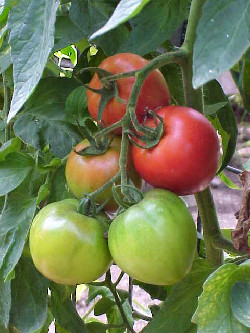Tasteless Tomatoes...little know fact

It's not big news that many modern tomatoes don't have the flavor of older varieties, especially those that have been bred primarily for commercial production. But some new research published recently in the journal Science may have at least a partial explanation as to why that's the case.
It turns out that selective breeding done to make it easier for commercial growers to judge when mature green tomatoes in the field are ready to be picked and shipped had some unexpected consequences. Growers knew that if uniformly light green tomatoes were picked and shipped to distant markets, by the time they arrived on store shelves, they would be the even red that customers look for. But many older tomato varieties have "green shoulders," areas at the top of the fruit remain a darker green. This uneven coloration made it hard for growers to know if a tomato had reached the "pickable" stage. So over the past seventy years or so, breeders have selected for varieties that develop a uniform green color when they are mature enough to harvest.
Unfortunately for consumers, however, it turns out that getting rid of the green shoulders also got rid of a gene called SIGLK2, whose function is to boost the level of sugars and other flavor compounds in the fruit as it ripens. Another recent study by Harry Klee of the University of Florida showed that the loss of this gene also diminished the volatile compounds a tomato gives off, aromatic compounds that contribute to our enjoyment of tomato taste through our sense of smell.
The loss of SIGLK2 gene and the green shoulders trait it codes for is not the only reason that modern tomatoes are short on flavor, but it is a piece of the puzzle. And for the best flavor among modern tomatoes? He suggests cherry tomatoes. These little varieties came late to the breeding party and he says, "Breeders haven't had as much time to mess them up."
It turns out that selective breeding done to make it easier for commercial growers to judge when mature green tomatoes in the field are ready to be picked and shipped had some unexpected consequences. Growers knew that if uniformly light green tomatoes were picked and shipped to distant markets, by the time they arrived on store shelves, they would be the even red that customers look for. But many older tomato varieties have "green shoulders," areas at the top of the fruit remain a darker green. This uneven coloration made it hard for growers to know if a tomato had reached the "pickable" stage. So over the past seventy years or so, breeders have selected for varieties that develop a uniform green color when they are mature enough to harvest.
Unfortunately for consumers, however, it turns out that getting rid of the green shoulders also got rid of a gene called SIGLK2, whose function is to boost the level of sugars and other flavor compounds in the fruit as it ripens. Another recent study by Harry Klee of the University of Florida showed that the loss of this gene also diminished the volatile compounds a tomato gives off, aromatic compounds that contribute to our enjoyment of tomato taste through our sense of smell.
The loss of SIGLK2 gene and the green shoulders trait it codes for is not the only reason that modern tomatoes are short on flavor, but it is a piece of the puzzle. And for the best flavor among modern tomatoes? He suggests cherry tomatoes. These little varieties came late to the breeding party and he says, "Breeders haven't had as much time to mess them up."
Labels: gardening, ILT Vignocchi, landscape, landscaping, tomatoes


0 Comments:
Post a Comment
Subscribe to Post Comments [Atom]
<< Home